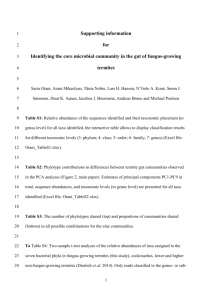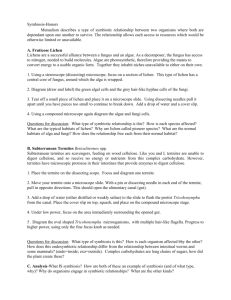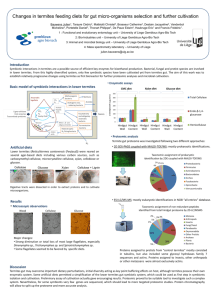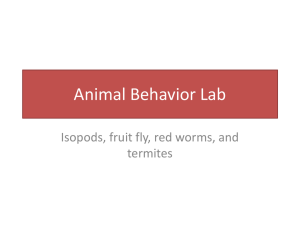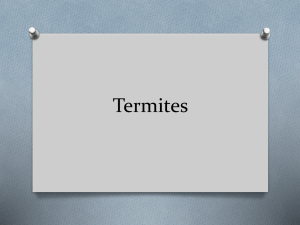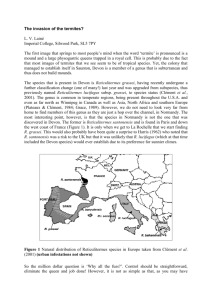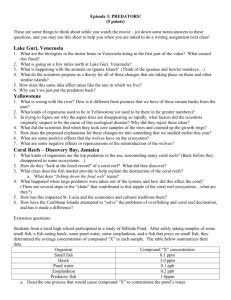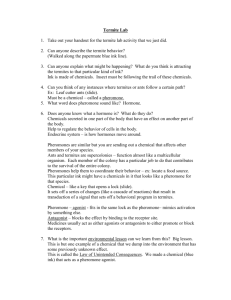Final Report - The Rufford Foundation
advertisement
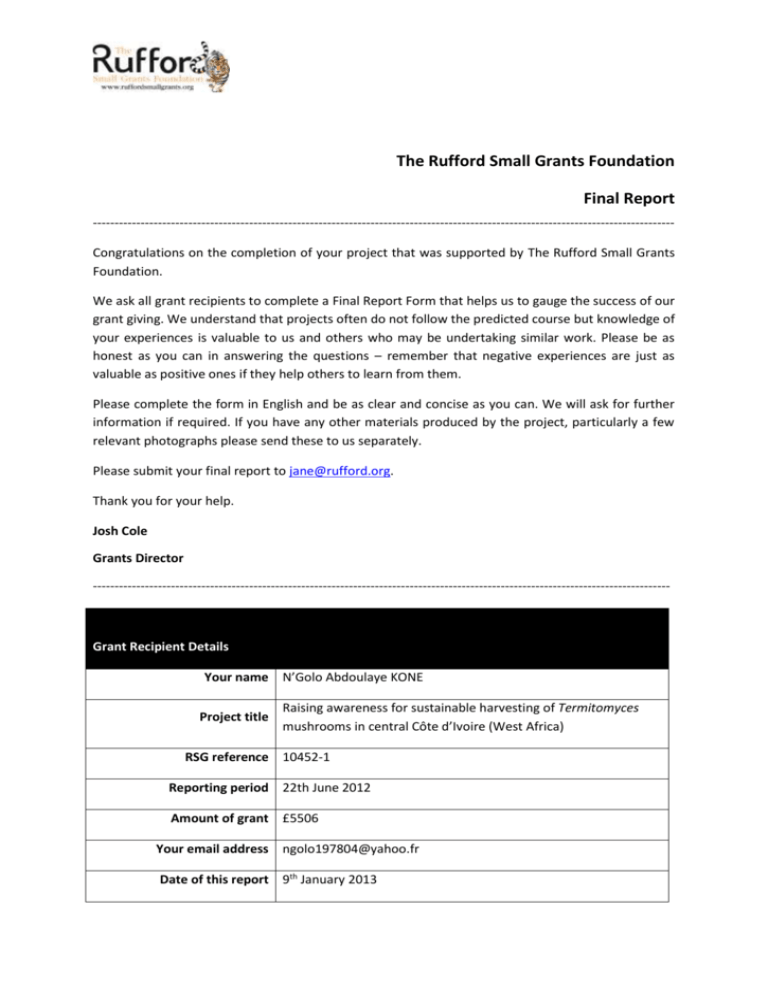
The Rufford Small Grants Foundation Final Report -------------------------------------------------------------------------------------------------------------------------------------Congratulations on the completion of your project that was supported by The Rufford Small Grants Foundation. We ask all grant recipients to complete a Final Report Form that helps us to gauge the success of our grant giving. We understand that projects often do not follow the predicted course but knowledge of your experiences is valuable to us and others who may be undertaking similar work. Please be as honest as you can in answering the questions – remember that negative experiences are just as valuable as positive ones if they help others to learn from them. Please complete the form in English and be as clear and concise as you can. We will ask for further information if required. If you have any other materials produced by the project, particularly a few relevant photographs please send these to us separately. Please submit your final report to jane@rufford.org. Thank you for your help. Josh Cole Grants Director ------------------------------------------------------------------------------------------------------------------------------------- Grant Recipient Details Your name N’Golo Abdoulaye KONE Project title Raising awareness for sustainable harvesting of Termitomyces mushrooms in central Côte d’Ivoire (West Africa) RSG reference 10452-1 Reporting period 22th June 2012 Amount of grant £5506 Your email address ngolo197804@yahoo.fr Date of this report 9th January 2013 1. Please indicate the level of achievement of the project’s original objectives and include any relevant comments on factors affecting this. Objective Generating quantitative data on their actual diversity, abundance, distribution and habitats characteristics Not achieved Partially achieved Identifying human pressure through land use intensification and harvesting methods Fully achieved x X Elaboration of collaboration strategies for Termitomyces species, host termites and their habitats X Raising public awareness through campaigns through pupils, collectors, x Comments Quantitative data was generated on the actual diversity and abundance of the extend fructification zone of Termitomyces in Côte d’Ivoire (extend savannah-forest boundaries, from the eastern to the western part of the country). However, our field observations revealed that there are threats pending upon the symbiotic fungi of the forest dwelling termites (e.g. Acanthotermes acanthotorax and Macrotermes subhyalinus). We should also especially work in the primary forest habitats in south and the west of the country. The current excessive deforestation and the subsequent conversion of the extend savannah-forest boundaries to agricultural land further threaten this particular symbiosis. Deforestation was identified as the main threat pending the diversity and abundance of Termitomyces species. However, their Intensive and uncontrolled harvest for consumption and trade, the collection of queens and sexual (alates) of the host termites and the resulting destruction of their nest also have a negative impact on the establishment of mature fungusgrowing termites’ colonies. These strategies were elaborated for the extend fructification zone of Termitomyces sporophores. However, in the rain forest zone new strategies have to be elaborated according the future studies in these areas. Indeed, exportation crops (cocoa, coffee, palm tree...) and their subsequent deforestation are privileged. This objective was fully achieved in our study area with the campaigns undertaken through this project. However, the results of this objective sellers and purchasers of these mushrooms Analysing option for production in disturbed habitats and promoting the consumption of other successful domesticated edible species as alternative need to be evaluated at the next fructification period of Termitomyces sporophores (February-May 2013). That could be done by the ministry of environment or through another project or permanent educational activities and awareness campaigns. The option of the production of Termitomyces sporophores under controlled conditions is just at the beginning. We are actually working on newly founded colonies of fungus growing termites in the laboratory. The promotion of other successful domesticated edible species as an alternative will the done through the training of rural people of some selected villages (via another project) on the cultivation of Pleurotus spp and Volvariella spp which are with Termitomyces species, the most consumed fungal sporophores in the country. X 2. Please explain any unforeseen difficulties that arose during the project and how these were tackled (if relevant). 1 2 Problems encountered We did not include the budget for repairing the car if needed. We have got some mechanical problems with the vehicle during the field works which needed to be solved. All the project sites were not accessible by car. We were then forced to use two rented motorbikes. Solutions used The funds were provided from the numeric camera and the portable electricity generator budgets. The funds for renting out the motorbikes were provided from the correspondences budget. Part of the budget devoted to transport, field trips and awareness campaigns was used to buy fuel to feed these motorbikes. 3. Briefly describe the three most important outcomes of your project. The three most important outcomes of our project were: 1. The effective implication of rural people and our ministry of environment in the execution and popularisation of the awareness campaign 2. The awareness of rural people for sustainable and long lasting use of fungus-growing termites and their symbiotic fungi. Most of them did not know that Termitomyces sporophores’ were cultivated by termites and that their persistence is related to that of these host termites and the good conservation of their habitats. 3. Important quantitative and qualitative data obtained on the diversity and abundance of Termitomyces from the extend savannah-forest boundaries of Côte d’Ivoire. This outcome will allow establishing the first monograph of edible mushrooms of this country. A check-list for Termitomyces of Côte d’Ivoire is been prepared and a red list will be prepared soon using IUCN criteria like Extinct, Critically Endangered, Endangered, Vulnerable, Near Threatened and Data Deficient. Finally, proposals for protection of rare and threatened Termitomyces in the country will be determine in the near future. 4. Briefly describe the involvement of local communities and how they have benefitted from the project (if relevant). The awareness campaign were done by some actors the harvest and collect chain of Termitomyces sporophores (commercial and subsistence harvesters, small and wholesalers of Termitomyces fruits bodies). We previously trained them and during the awareness campaign we used them as technicians to educate the rural people in their respective mother taught on the necessity to sustainably use the Termitomyces sporophores and their host fungus-growing termites. 5. Are there any plans to continue this work? It is absolutely important and fundamental to continue this work by extending the study area. For the ecological survey, there is need have an inventory and a long term monitoring in the forest zones (West and South of the country) and the Soudano-Zambesian woodlands in the east to produce an accurate, comprehensive and useful red list for the Termitomyces species of Côte d’Ivoire. Fructification periods were found differing from a Termitomyces species to another on one hand and from an area to another on the other hand. Hence, there is a need to carry out a national ecological survey of the macro-fungi in general and Termitomyces particularly as a prelude to conservation of these organisms in this country. Furthermore, there is a need of establishing a permanent educational activities and awareness campaigns on the diversity and sustainable use of edible fungi in general. 6. How do you plan to share the results of your work with others? We plan to share the results of our work with others through publications. We already made a publication in a national bimonthly agricultural magazine (Le Planteur) for the general public and stakeholders of our country. We also plan to analyse some of the important results obtained during this work and published them in a scientific peer review journal of biodiversity conservation. Furthermore, in order to maintain people awareness on the necessity of sustainably using Termitomyces sporophores and their host termites, scientific review for general people such as topic in the future edition of the biodiversity atlas of Côte d’Ivoire, will also be written with the rest of the results. 7. Timescale: Over what period was the RSG used? How does this compare to the anticipated or actual length of the project? The project was executed from January to December 2012. The grants will be use until the end of January 2013, though the project is still ongoing as data analysis is still been done for the ecological diversity study (morphological identification, writing scientific publication, and review for general people). We received funds on October 2011 and the project started on 01st January 2012. 8. Budget: Please provide a breakdown of budgeted versus actual expenditure and the reasons for any differences. All figures should be in £ sterling, indicating the local exchange rate used. Item Budgeted Amount 940 Actual Amount 900 Difference Digital photo camera Canon EOS 1000D + supplementary batteries, tripod... Electricity generator + fuel for awareness campaign in villages without electricity Office and informatics automation Printing of posters, brochures, Conservation manual… Specimens collecting and conservation material 900 650 -250 665 550 -115 200 200 0 500 505 +5 300 397 +97 Transport 1351 1655 +304 Salaries of local guides and 500 technicians Correspondences 150 595 +95 145 -5 TOTAL 5597 +91 Video projector + accessories 5506 Comments -40 We bought a Canon EOS 1000D instead of Canon EOS 50D This remaining money was used to repair car during the field work. Funds were needed to for chemical reagents (Congo red Melzer’s) used for the identification of fungus sporophores and CTAB (Cethyl Trimethyl Ammonium Bromide) used for the good conservation for future molecular analyses (if relevant). Motorbikes were rented out for field works in inaccessible work sites. In addition fuel for the vehicle was underestimated. The local exchange rate is: £1 = 741 XOF 9. Looking ahead, what do you feel are the important next steps? The important next steps are: (i) Improve our comprehension of the fructification of the symbiotic Termitomyces in the fungus growing termites’ colonies by modelling developmental stages within these colonies under laboratory conditions. The aims of these studies will be the determination of the relationship between the life cycle of fungus growing termites and the seasonal fructification of their symbiotic fungus in incipient colonies under laboratory conditions. Modelling colonies growth in fungus termites will be an innovative work on the way of understanding the fructification of the symbiotic fungus in this symbiotic relationship. (ii) The promotion of other successful domesticated edible species as an alternative for the sustainable management of Termitomyces sporophores will be done through the training of rural people of some selected villages (via another project) on the cultivation of Pleurotus spp and Volvariella spp. This kind of project could help reducing the threats pending upon the Termitomyces species. Furthermore, these edible fungal cultivation activities could represent another source of income for rural people and reducing by the way the pressure on habitats of Termitomyces. (iii) Institute permanent awareness campaign of biodiversity conservation and the management of natural resources 10. Did you use the RSGF logo in any materials produced in relation to this project? Did the RSGF receive any publicity during the course of your work? The RSGF logo was used in all the oral communications of the awareness campaigns intended to raise awareness for the sustainable management and harvest of the edible mushrooms of the genus Termitomyces. I will also use the RSGF logo in the presentation of the oral defence of my PhD thesis which planned for the 31th January 2013.
